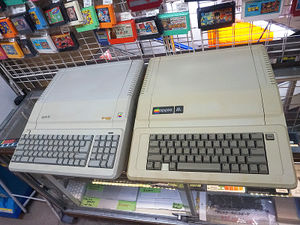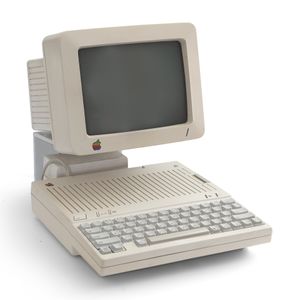Difference between revisions of "Apple II"
(→Incremental successors) |
(→Apple IIc Plus) |
||
| Line 43: | Line 43: | ||
=== Apple IIc Plus === | === Apple IIc Plus === | ||
| − | The Apple IIc Plus is the final model in the Apple II series. It was released in september 1988, 2 years after the Apple IIgs. It uses the same case as the Apple IIc but the 6502 CPU is clocked at 4MHz instead of 1.023MHz for the Apple IIc. And it is equipped with a 3.5inch floppy drive instead of the 5.25inch floppy drive of the Apple IIc. | + | The Apple IIc Plus is the final model in the Apple II series. It was released in september 1988, 2 years after the Apple IIgs. It uses the same case as the Apple IIc but the 6502 CPU is clocked at 4MHz instead of 1.023MHz for the Apple IIc. And it is equipped with a 3.5inch floppy drive instead of the 5.25inch floppy drive of the Apple IIc, offering 6 times the storage capacity and fast loading time. |
<br> | <br> | ||
Revision as of 21:12, 4 March 2025
First launched in 1977, the Apple II was one of the original home computers and the first to offer colour graphics and built-in audio by default.
A 6502 machine, it is noteworthy for a design philosophy in which:
- non-processor actions, such as changing video mode or toggling the speaker, are triggered as a function of address decoding not of hardware registers — e.g. if you access address `C057` then you will set the current graphics mode to 'high resolution' regardless of whether you perform a read or a write, and in the latter case of what you write;
- not even tasks like colour generation are abstracted — the programmer is given a 1bpp pixel output that is in-phase with the NTSC video signal and is expected to generate colours through proper placement of dots; and
- there are zero interrupt sources in an unexpanded machine. There is no way to keep track of time other than processor cycle counting.
Contents
Input
The keyboard cannot communicate multiple simultaneous keypresses, which makes playing games by keyboard difficult.
However, it is equipped with analogue and trigger inputs, which are most commonly used for two two-axis analogue joysticks with two buttons, accepted by the majority of games.
Audio
Although the base machine has only a simple binary toggle speaker, all versions of the machine other than the IIc provide expansion slots, allowing a large number of audio options to emerge.
Of those, the Mockingboard has the best game support. Various configurations of the Mockingboard were available with different combinations of AY-3-8910 and Votrax SC-01 (or compatible) speech synthesiser chips, connected via 6522s which also provide timed interrupt sources for the CPU. The best-supported configuration carries two AY-3-8910s and two 6522s.
Some software products even supported more than one Mockingboard. Ultima V supported two boards, for a total of 12 voices, of which it used eight.
Incremental successors
Apple II+
The original machine was followed up by the II+, which includes a better BASIC and can automatically boot from a disk drive if attached.
The II and II+ lack the capacity for lowercase text entry and cannot display lowercase letters in their clean text mode.
Apple IIe
The Apple IIe (styled as Apple //e) is the third model in the Apple II series. It was released in January 1983 as the successor to the Apple II Plus. The e in the name stands for enhanced. It is the first Apple II with built-in lowercase and 80-column text support, as well as 64K RAM, while reducing the total chip count from previous models by approximately 75%.
Apple IIc
The Apple IIc is the fourth model in the Apple II series. It was introduced shortly after the launch of the original Macintosh in 1984. The c in the name stands for compact. It is essentially a remarkably compact version of the Apple IIe. The IIc has a built-in 5.25inch floppy disk drive, and was often sold with its matching monitor.
Apple IIc Plus
The Apple IIc Plus is the final model in the Apple II series. It was released in september 1988, 2 years after the Apple IIgs. It uses the same case as the Apple IIc but the 6502 CPU is clocked at 4MHz instead of 1.023MHz for the Apple IIc. And it is equipped with a 3.5inch floppy drive instead of the 5.25inch floppy drive of the Apple IIc, offering 6 times the storage capacity and fast loading time.
Next generation
Apple IIgs
The Apple IIgs is equipped with a 65816 CPU, the 16-bit evolution of the 6502 CPU. It was released in september 1986. The gs in the name stands for graphics and sound. It is equipped with superior graphics (640x200 in 4 colours, 320x200 in 16 colours, with 4096 colour palette), an high-end Ensoniq 32-voice soundchip, a separate keyboard and mouse, and a Macintosh-like Graphical User Interface.
Links
- Apple II Reference Manuals
- How the Apple II Works! by The 8-Bit Guy
- Inside the Apple II by Stephen Edwards
- Apple II composite artifact color
- The very best of the Apple II Over 50 Apple II games in under 30 minutes Over 100 Apple IIGS games in under 1 hour
- https://mirrors.apple2.org.za Mirrors popular Apple II file servers

